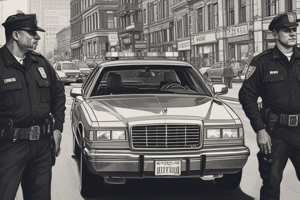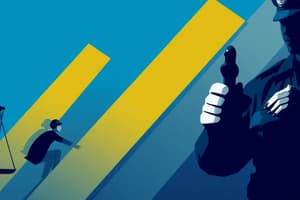Podcast
Questions and Answers
Which of the following is a core component of the criminal justice system?
Which of the following is a core component of the criminal justice system?
- Transportation
- Healthcare
- Education
- Corrections (correct)
What is the primary responsibility of law enforcement?
What is the primary responsibility of law enforcement?
- Managing prisons
- Preventing, detecting, and investigating crimes (correct)
- Creating new laws
- Adjudicating criminal cases
Which of the following is a goal of the criminal justice system?
Which of the following is a goal of the criminal justice system?
- Creating unemployment
- Maintaining order (correct)
- Ignoring laws
- Promoting inequality
Which type of crime involves the use of force or threat of force?
Which type of crime involves the use of force or threat of force?
Which of the following is an example of a property crime?
Which of the following is an example of a property crime?
What is the role of appellate courts?
What is the role of appellate courts?
What is the purpose of jails?
What is the purpose of jails?
What is the purpose of probation?
What is the purpose of probation?
What is the conditional release of inmates from prison before their sentence expires called?
What is the conditional release of inmates from prison before their sentence expires called?
Which of the following is an example of Community Corrections?
Which of the following is an example of Community Corrections?
Which step in the criminal justice process involves informing the suspect of the charges against them?
Which step in the criminal justice process involves informing the suspect of the charges against them?
What is the purpose of a preliminary hearing?
What is the purpose of a preliminary hearing?
Which amendment protects against unreasonable searches and seizures?
Which amendment protects against unreasonable searches and seizures?
What does the presumption of innocence mean?
What does the presumption of innocence mean?
What is the primary focus of juvenile justice?
What is the primary focus of juvenile justice?
Which theory emphasizes free will and rational choice in criminal behavior?
Which theory emphasizes free will and rational choice in criminal behavior?
What does the Uniform Crime Reporting (UCR) system collect data on?
What does the Uniform Crime Reporting (UCR) system collect data on?
Which of the following is an example of a contemporary issue in criminal justice?
Which of the following is an example of a contemporary issue in criminal justice?
Flashcards
Criminal Justice System
Criminal Justice System
Practices and institutions aimed at social control, crime deterrence, and sanctioning law violators.
Law Enforcement Role
Law Enforcement Role
Preventing, detecting, and investigating crimes to maintain order and enforce laws.
Function of Courts
Function of Courts
Adjudicate criminal cases and ensure fair legal proceedings in the justice system.
Corrections System
Corrections System
Signup and view all the flashcards
Violent Crimes
Violent Crimes
Signup and view all the flashcards
White-Collar Crimes
White-Collar Crimes
Signup and view all the flashcards
Trial Courts Purpose
Trial Courts Purpose
Signup and view all the flashcards
Probation Defined
Probation Defined
Signup and view all the flashcards
Parole
Parole
Signup and view all the flashcards
Investigation (Criminal Justice)
Investigation (Criminal Justice)
Signup and view all the flashcards
Arraignment
Arraignment
Signup and view all the flashcards
Due Process
Due Process
Signup and view all the flashcards
Presumption of Innocence
Presumption of Innocence
Signup and view all the flashcards
Fourth Amendment
Fourth Amendment
Signup and view all the flashcards
Juvenile Justice
Juvenile Justice
Signup and view all the flashcards
Social Learning Theory
Social Learning Theory
Signup and view all the flashcards
Dark Figure of Crime
Dark Figure of Crime
Signup and view all the flashcards
Ethics in Criminal Justice
Ethics in Criminal Justice
Signup and view all the flashcards
Study Notes
- Criminal justice involves governmental systems and practices that maintain social order.
- It focuses on deterring and mitigating crime.
- Criminal justice includes imposing criminal penalties and rehabilitation.
Core Components
- Law Enforcement prevents, detects, and investigates crimes.
- Courts handle criminal cases and ensure fair legal proceedings occur.
- Corrections manages convicted individuals via incarceration, probation, and parole.
Goals of Criminal Justice
- Maintaining Order preserves peace and prevents social disruption.
- Enforcing Laws upholds legal standards and ensures compliance.
- Protecting Rights safeguards individual freedoms and ensures due process.
- Punishing Offenders imposes sanctions on lawbreakers.
- Rehabilitation provides opportunities for offenders to reintegrate into society.
- Deterrence discourages potential offenders from committing crimes.
Types of Crime
- Violent Crimes involve force or the threat of it, including homicide, robbery, and assault.
- Property Crimes target property, such as burglary, larceny, and arson.
- White-Collar Crimes are nonviolent crimes for financial gain (fraud, embezzlement).
- Drug Offenses relate to possessing, selling, or making illegal drugs.
- Public Order Offenses disrupt public peace, like disorderly conduct and public intoxication.
Law Enforcement
- Police are primary agencies for maintaining order and investigating crimes.
- Sheriffs are elected officials overseeing law enforcement in a county.
- Their duties include managing jails and providing court security.
- Federal Agencies such as the FBI, DEA, and ATF enforce federal laws.
- Responsibilities include patrolling, responding to calls, conducting investigations, and making arrests.
Courts
- Trial Courts conduct trials to determine guilt or innocence.
- Appellate Courts review lower court decisions for legal errors.
- Supreme Courts are the highest appellate courts, interpreting laws and setting precedents.
- Key Actors include judges, prosecutors, defense attorneys, and juries.
Corrections
- Prisons are for long-term incarceration of convicted felons.
- Jails are for short-term detention of those awaiting trial or serving misdemeanor sentences.
- Probation involves supervised release of offenders into the community, subject to conditions.
- Parole is the conditional release of inmates from prison before their sentence expires.
- Community Corrections includes halfway houses, electronic monitoring, and restorative justice programs.
Criminal Justice Process
- Investigation involves collecting evidence and identifying suspects.
- Arrest means taking a suspect into custody based on probable cause.
- Arraignment is where a suspect is informed of the charges and enters a plea.
- Preliminary Hearing determines if sufficient evidence exists for a trial.
- Plea Bargaining involves negotiation for a guilty plea in exchange for a lighter sentence.
- Trial is a formal examination of evidence before a judge or jury.
- Sentencing means imposing penalties on a convicted offender.
- Appeals is when a higher court reviews a trial court's decision.
- Incarceration involves confinement in a correctional facility.
- Release is the transition of an offender back into the community.
Legal Principles
- Due Process ensures fair treatment, protecting individual rights.
- Presumption of Innocence means accused individuals are innocent until proven guilty.
- Fourth Amendment protects against unreasonable searches and seizures.
- Fifth Amendment guarantees the right to remain silent and protects against self-incrimination.
- Sixth Amendment assures the right to a speedy trial, the right to counsel, and the right to confront witnesses.
- Eighth Amendment prohibits cruel and unusual punishment.
- Fourteenth Amendment guarantees equal protection under the law.
Juvenile Justice
- Focuses on rehabilitating young offenders rather than strict punishment.
- Separate court systems and procedures exist for juveniles.
- Emphasis is placed on interventions and services addressing delinquency's causes.
Criminal Justice Reform
- Addresses issues like mass incarceration, racial disparities, and police brutality.
- Initiatives include bail reform, sentencing reform, and alternatives to incarceration.
- Focuses on rehabilitation, reintegration, and reducing recidivism.
Theories of Crime
- Classical Criminology emphasizes free will and rational choice in criminal behavior.
- Positivist Criminology focuses on biological, psychological, and social factors influencing crime.
- Social Learning Theory says criminal behavior is learned through interactions.
- Strain Theory suggests crime results from strain when goals can't be achieved legitimately.
- Labeling Theory indicates deviant behavior is influenced by societal labels.
Data and Measurement
- Crime Rates are statistical measures of crime incidence in an area.
- Uniform Crime Reporting (UCR) is an FBI program collecting crime data.
- National Crime Victimization Survey (NCVS) surveys households to measure crime victimization.
- Dark Figure of Crime refers to crimes that go unreported.
Contemporary Issues
- Cybercrime involves crimes committed using computers and the internet.
- Terrorism involves using violence for political purposes.
- Mass Shootings are incidents involving multiple gun violence victims.
- Human Trafficking exploits individuals for forced labor or sexual exploitation.
- Drug Epidemics are public health crises related to drug abuse and addiction.
Ethics in Criminal Justice
- Law Enforcement Ethics involves standards of conduct for police officers.
- These standards cover integrity, fairness, and respect for rights.
- Prosecutorial Ethics means prosecutors must seek justice and ensure fair trials.
- Judicial Ethics covers principles of impartiality, integrity, and competence for judges.
- Correctional Ethics involves standards for treating inmates humanely and maintaining security.
International Criminal Justice
- Focuses on crimes transcending national boundaries, such as genocide and war crimes.
- International Criminal Court (ICC) prosecutes individuals for serious international crimes.
- Extradition is transferring a suspect from one country to another.
- Interpol facilitates cooperation between police forces worldwide.
Victimology
- Studies the role of victims in crime and its impact on them.
- Victim Services are programs that support crime victims.
- Victim Rights are legal protections, such as the right to be informed and receive restitution.
Studying That Suits You
Use AI to generate personalized quizzes and flashcards to suit your learning preferences.




